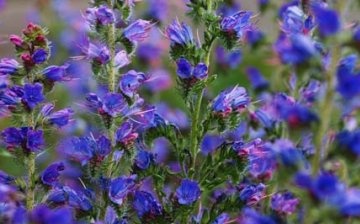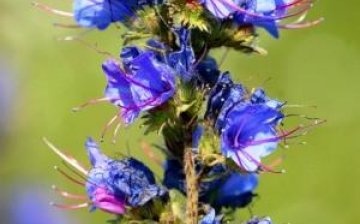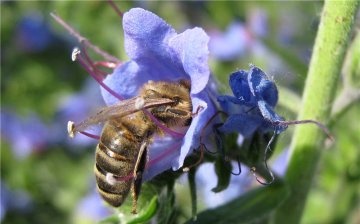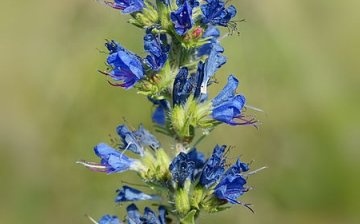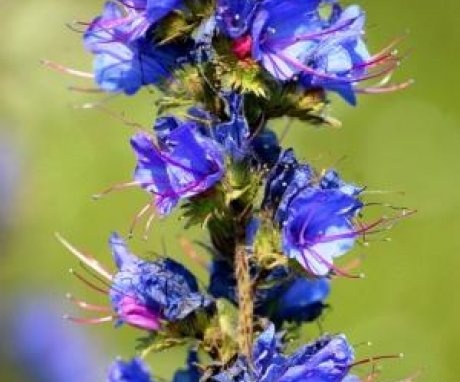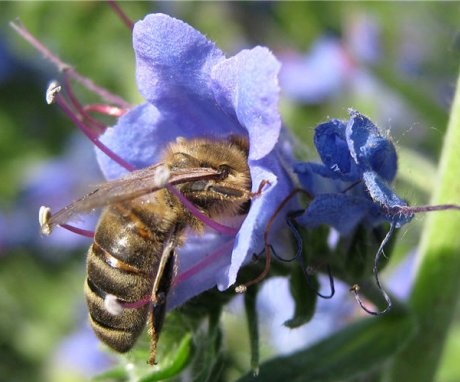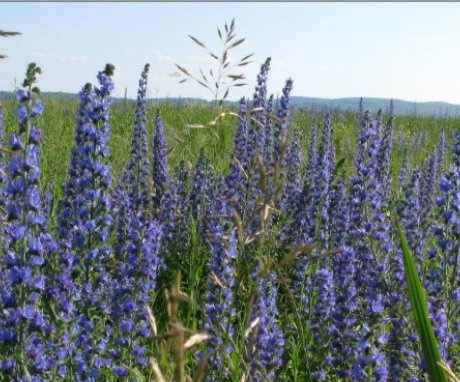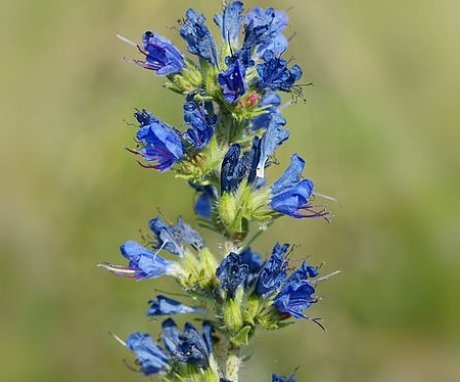The bruise plant is one of the best honey plants
Every beekeeper should understand not only bees and honey varieties, but also flowers, honey plants and pollen plants. One of these plants is the common bruise. Bruise is a biennial plant that reaches a height of as much as 1.5 meters. The plant blooms only in the second year and after that it stops its life cycle. The bruise belongs to the Burachnikov family.
Content:
- Description of the plant bruise ordinary
- The value of a bruise as a melliferous plant
- Growing a plant
- Other benefits of bruising
Description of the plant bruise ordinary
Although the plant is a honey plant, its flowers are still larger than those of other representatives.
Raster characteristic:
- The flowering period lasts from May to July. At the beginning of flowering, the flowers at the bruise are pink, and by the end of the term they become bright blue.
- Casting plants are sessile, linear lanceolate, the base is round.
- Flowers are collected in panicle inflorescence.
- The corolla can be of different colors, ranging from white to blue, funnel-shaped in shape.
There is another type of bruise, which, like the ordinary one, is used in folk medicine, this is the Russian bruise (blush).
It reaches a height of no more than 50 cm, its flowers are similar to an ordinary species, but have a burgundy color. Bruise blooms Russian in another period - from June to August. In the wild, the plant is widespread in the Sakhalin region of Russia, the Amur region, the European part of Russia and in Central Asia, in particular in the Tashkent and Samarkand regions.
The root system of the flower has a pronounced stem that goes deep into the ground. Only the aerial part of the plant is used as a raw material.
But you should be careful: a bruise is a poisonous plant, as it contains choline, saponins, consolidin and cinoglossin.
Under natural conditions, the bruise prefers dry soils, steppes, rocky places. It can take root anywhere and does not require much maintenance, so it can often be found on the streets right on the side of the road.
The value of a bruise as a melliferous plant
Large areas are not purposefully sown with a bruise, because it is a kind of weed, although it is has useful properties... For a beekeeper, it will be a good addition to his apiary if it is sown with a bruise around it.
The value of a flower for a beekeeper is primarily honey productivity itself.
Different sources provide different figures, some claim that 300 kg of honey can be harvested from one hectare, and some that as much as 800 kg. Professionals can confirm that this is a high figure for any honey flower.
All day long, bees fly around the bruise and collect pollen and nectar. Even if the weather is unfavorable: wet and cold, it still does not affect its performance. The honey obtained from the bruise plant can be stored for a long time, it can be with bees all winter and will not crystallize. The color of honey turns out to be light amber, it is thick in consistency and has a pronounced sweet taste and smell.
You can propagate a bruise yourself, choosing meadows and desert areas around the apiary.
But it is worth waiting for a few years, as it begins to spread on its own, as all weeds do. In a small apiary, a pleasant result will be noticeable in a few years.
It is considered normal to sow about 4 kg of bruise seeds per hectare. There are about 3000 pieces of them in 10 grams of seeds. The seeds are very small and easy to plant. Seeds are planted to a depth of about 2 cm in spring or autumn. If planting occurs in the fall, then this should be done in warm weather and early, so that the first shoots have time to appear before the first cold weather. Any soil will doeven the poorest, it does not require any maintenance, plowing or fertilization.
Growing a bruise
It would seem, why bother cultivating weed, but these questions disappear as soon as a person learns about its valuable qualities and honey production.
Before choosing seeds for growing, you need to be familiar with the climate of the region.
If you start sowing in the fall, then you should not wait for the cold weather, otherwise the seedlings will appear small and weak, and in winter they will simply die. In order to discard all risks, it is better to wait for spring so that the plants are strong and survive the winter well.
The sowing period is not critical, the deadline may be May, and even June:
- Any soil is suitable for a bruise, but it is better to choose a place that is more sunny and open.
- Since the grower has the right to choose, it is better to give preference to fertile, loose soil, the alkalinity indicator should be weak or neutral. This will guarantee better flowering, which means that there will be much more honey and raw materials, which is the ultimate goal.
- You can sow bruise seeds with your hands, but if the area is large, it is recommended to use a grass seeder.
- The sowing should not be dense, only 5 kg of seeds are sown per hectare.
- Seeds are laid to a depth of 2-3 cm, and they begin to germinate at a temperature of at least +10 degrees. The most favorable air temperature for flowering is from +20 to +30 degrees.
- In the future, the plant does not need any agrotechnical measures. But applying organic fertilizer will not harm him. If possible and desire to fertilize, as a result, the bruise will delight you with lush flowering.
In the first year, the bruise will not bloom, since it is a biennial, so beekeepers plant phacelia or any other annual honey plant at the same time as the bruise. In this way, the bees will have the "soil" to collect honey annually without interruption. Watering the bruise is not necessary, it belongs to the drought-resistant species. In the future, the flower is sown by itself and displaces the surrounding plants.
Other benefits of bruising
Despite the fact that the plant reads poisonous, it is widely used in folk medicine.
The aboveground part of the plant, that is, leaves and flowers, is used as a raw material. They are collected at the very beginning of flowering, when the flowers are still pinkish, then they have the most valuable components.
The main substances in the composition are:
- Alkaloids.
- Saponins.
- Vitamin C.
A decoction of dry raw materials is used for various diseases.
For example, a mixture of both flowers and leaves is used as a sedative and expectorant. Decoction recipe: 1 dessert spoon of dry raw materials is poured with 200 ml of water and put on a small fire. After 20 minutes, strain and squeeze the broth. Take 1/3 cup 3 times a day.
External use of a bruise is useful for:
- Stretching the tendons.
- Gout.
- Arthritis.
- Rheumatism.
It is very important to prevent an overdose of the plant, as it is poisonous, so if such treatment does not give results or unpleasant side effects appear, stop taking it and consult a doctor.
Additional properties of a bruise are calming the nervous system, reducing the number of seizures, and removing toxins from the body.
The herb infusion is used for epilepsy and a poisonous snake bite. Another important property of the plant is blood-purifying, but for this only the roots of the bruise are used. Its roots also have antibacterial and antifungal properties.Even scientific medicine has not passed the bruise and recommends using it for severe coughs, in particular whooping cough.
More information can be found in the video.



